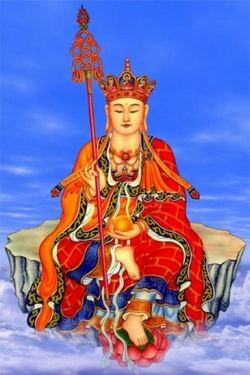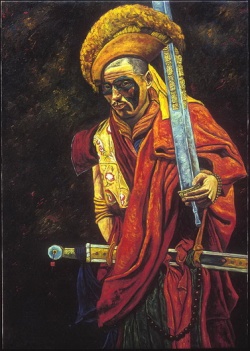Buddhism’s Disappearance from India
Vinay Lal
One of the supreme ironies of the history of Buddhism in India is the question of how Buddhism came to disappear from the land of its birth. Many scholars of Buddhism, Hinduism, Indian history, and of religion more generally have been devoted to unraveling this puzzle. There is no absolute consensus on this matter, and a few scholars have even contended that Buddhism never disappeared as such from India. On this view, Buddhism simply changed form, or was absorbed into Hindu practices. Such an argument is, in fact, a variation of the view, which perhaps has more adherents than any other, that Buddhism disappeared, not on account of persecution by Hindus, but because of the ascendancy of reformed Hinduism. However, the view that Buddhists were persecuted by Brahmins, who were keen to assert their caste supremacy, still has some adherents, and in recent years has been championed not only by some Dalit writers and their sympathizers but by at least a handful of scholars of pre-modern Indian history. [1]
What is not disputed is the gradual decline of Buddhism in India, as the testimony of the Chinese traveler, Hsuan Tsang, amply demonstrates. Though Buddhism had been the dominant religion in much of the Gangetic plains in the early part of the Christian era, Hsuan Tsang, traveling in India in the early years of the 7th century, witnessed something quite different. In Prayag, or Allahabad as it is known to many, Hsuan Tsang encountered mainly heretics, or non-Buddhists, but that is not surprising given the importance of Prayag as a pilgrimage site for Brahmins. But, even in Sravasti, the capital city of the Lichhavis, a north Indian clan that came to power around 200 AD, established their capital in Pasupathinath, and in a long and glorious period of reign extending through the early part of the ninth century endowed a large number of both Hindu and Buddhist monuments and monasteries, Hsuan Tsang witnessed a much greater number of “Hindus” (ie, non-Buddhists, such as Jains and Saivites) than Buddhists. Kusinagar, the small village some 52 kilometres from Gorakhpur where the Buddha had gone into mahaparinirvana, was in a rather dilapidated state and Hsuan Tsang found few Buddhists. In Varanasi, to be sure, Hsuan Tsang found some 3000 Bhikkus or Buddhist monks, but they were outshadowed by more than 10,000 non-Buddhists. There is scarcely any question that Hsuan Tsang arrived in India at a time when Buddhism was entering into a state of precipitous decline, and by the 13th century Buddhism, as a formal religion, had altogether disappeared from India. [2] But even as Buddhism went into decline, it is remarkable that the great seat of Buddhist learning, Nalanda, continued to flourish, retaining its importance until the Muslim invasions of the second millennium. Moreover, it is from Nalanda that Padmasambhava carried Buddhism to Tibet in the eighth century. Consequently, even the story of Buddhism in India cannot be unequivocally written in a single register of decline.
To consider the question somewhat more systematically, we might wish to consider in serial order the various reasons advanced for Buddhism’s decline and disappearance from India. The various arguments can be grouped under the following headings: sectarian and internal histories, focusing on schisms within the Buddhist faith, the widening differences between the clergy, Bhikkus, and laity, and the growing corruption within the sangha; histories focused on Buddhism’s relations with Brahmanism, dwelling on the alleged persecution of Buddhists by Brahmins, the defeat of the Buddhists by the great theologian Shankara in public debates, as well as on the supposedly characteristic tendency of Hinduism, or rather Brahmanism, to absorb its opponents; and, finally, secular and political histories, which emphasize the withdrawal of royal patronage from Buddhism and, later, the Muslim invasions which had the effect of driving into extinction an already debilitated faith.
Turning our attention to what I have described as sectarian histories, it is generally conceded that the Buddhist clergy paid insufficient attention to its laity. Buddhist mendicants kept their distance from non-mendicants, and as scholars of Buddhism have noted, no manual for the conduct of the laity was produced until the 11th century. Non-mendicants may not have felt particularly invested in their religion, and as the venues where the mendicants and non-mendicants intersected gradually disappeared, the laity might have felt distanced from the faith. The contrast, in this respect, with Jainism is marked. Some scholars have also emphasized the narrative of decay and corruption within a faith where the monks had come to embrace a rather easy-going and even indolent lifestyle, quite mindless of the Buddha’s insistence on aparigraha, or non-possession. The Buddhist monasteries are sometimes described as repositories of great wealth.
The secular and political histories adopt rather different arguments. It has been argued that royal patronage shifted from Buddhist to Hindu religious institutions. Under the Kushanas, indeed even under the Guptas (325-497 AD), both Buddhists and adherents of Brahmanism received royal patronage, but as Brahmanism veered off, so to speak, into Vaishnavism and Saivism, and regional kingdoms developed into the major sites of power, Buddhism began to suffer a decline. The itinerant Buddhist monk, if one may put it this way, gave way to forms of life less more conducive to settled agriculture. The Palas of Bengal, though they had been hospitable to Vaishnavism and Saivism, were nonetheless major supporters of Buddhism. However, when Bengal came under the rule of the Senas (1097-1223), Saivism was promulgated and Buddhism was pushed out -- towards Tibet.
Though Buddhism had already entered into something of a decline by the time of Hsuan Tsang’s visit to India during the reign of Harsha of Kanauj in the early seventh century, it has also been argued that its further demise, particularly in the early part of the second millennium AD, was hastened by the arrival of Islam. On this view, Buddhism found competition in Islam for converts among low-caste Hindus. Even Ambedkar, whose animosity towards Hinduism is palpable, was nonetheless firmly of the view that Islam dealt Buddhism a death blow. As he was to put it, “brahmanism beaten and battered by the Muslim invaders could look to the rulers for support and sustenance and get it. Buddhism beaten and battered by the Muslim invaders had no such hope. It was uncared for orphan and it withered in the cold blast of the native rulers and was consumed in the fire lit up by the conquerors.” Ambedkar was quite certain that this was “the greatest disaster that befell the religion of Buddha in India.” We thus find Ambekdar embracing the “sword of Islam thesis”: “The sword of Islam fell heavily upon the priestly class. It perished or it fled outside India. Nobody remained alive to keep the flame of Buddhism burning.” [3] There are, of course, many problems with this view. The “sword of Islam” thesis remains controversial, at best, and many reputable historians are inclined to dismiss it outright. Islam was, moreover, a late entrant into India, and Buddhism was showing unmistakable signs of its decline long before Islam became established in the Gangetic plains, central India, and the northern end of present-day Andhra and Karnataka.
Many narrative accounts of Buddhism’s decline and eventual disappearance from the land of its faith have been focused on Buddhism’s relations with Hinduism or Brahmanism. Nearly 20 years ago the historian S. R. Goyal wrote that "according to
many scholars hostility of the Brahmanas was one of the major causes of the decline of Buddhism in India." The Saivite king, Shashanka, invariably appears in such histories as a ferocious oppressor of the Buddhists, though the single original source for all subsequent narratives about Shashanka’s ruinous conduct towards Buddhists remains Hsuan Tsang. Shashanka is reported to have destroyed the Bodhi tree and ordered the destruction of Buddhist images. Hindu nationalists appear to think that many Muslim monuments were once Hindu temples, but partisans of Buddhism are inclined to the view that Hindu temples were often built on the site of Buddhist shrines.
If some scholars focus on outright persecution, others speak of a long process during which Buddhist practices became absorbed into Hinduism. The doctrine of ahimsa may have originated with the Buddha, and certainly found its greatest exposition in the Buddha’s teachings, but by the second half of the 1st millennium AD it had become part of Hindu teachings. The great Brahmin philosopher, Shankaracharya (c. 788-820 AD), is said to have engaged the Buddhists in public debates and each time he emerged triumphant. Monastic practices had once been unknown in Brahminism, but over time this changed. Shankaracharya himself established maths or monasteries at Badrinath in the north, Dwarka in the west, Sringeri in the south, and Puri in the east. The Buddha had, as is commonly noticed, been transformed into an avatara (descent) of Vishnu. The tendency of Hinduism to absorb rival faiths has been commented upon by many, though one could speak equally of the elements from other faiths that have gone into the making of Hinduism. Was Buddha absorbed into the Hindu pantheon so that Buddhism might become defanged, or is it the case that Buddhism stood for certain values that Hinduism was eager to embrace as its own?
Though many Dalit and other anti-Brahminical writers would like to represent Brahminism as a tyrannical faith that wrought massive destruction upon the Buddhists [see www.dalistan.org], the matter is more complicated. A recent study of the Bengal Puranas indubitably shows that the Buddhists were mocked, cast as mischievous and malicious in Brahminical narratives, and subjected to immense rhetorical violence. But rhetorical violence is not necessarily to be read as physical violence perpetrated upon the Buddhists, any more than accounts of thousands of Hindu temples destroyed at the hands of Muslim invaders are to be read literally. Similarly, the absorption of the Buddha into Vishnu’s pantheon may have represented something of a compromise between the Brahmins and Buddhists: since so much of what Buddhism stood for had been incorporated into certain strands of Brahminism, the Buddha was at least to be given his just dues. This anxiety of absorption continues down to the present day, and one of the more curious expressions of this anxiety must surely be a letter from the All India Bhikkhu Sangha to the-then Prime Minister of India, P. V. Narasimha Rao. In his letter of 23 February 1995, the President of the Sangha complained that the actor Arun Govil, who had played Rama in the TV serial Ramayana, had been chosen to play the Buddha in the TV serial by the same name. Could anyone really play the Buddha? “As you know,” the letter reminds Rao, “the Buddha was never a mythological figure as Rama & Hanuman but very much a historical figure.” [5] If nothing else, we might at least read the disappearance of Buddhism from India as a parable about how myth always outlives history.


